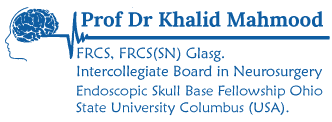What is keyhole surgery & is it right for you?
Keyhole surgery is the concept of safely removing brain & skull base tumors through smaller, more precise openings that minimize collateral damage to surrounding scalp, brain, blood vessels & nerves.
Fortunately, given advances over the last two decades in technology and instrumentation as well improved brain and skull base anatomical understanding, a majority of brain and skull base tumors can now be removed via one of these approaches using a small craniotomy (bony skull opening) or an approach through the nostrils.
Notably, these approaches are technically demanding, require specialized instrumentation, significant surgical expertise and are not appropriate for all tumors. Consequently, there remains a role for conventional larger craniotomies.
Keyhole Surgical Approaches
The ideal surgical approach for each patient is determined by the specific tumor type and location. Regardless of the route chosen, our goals are to maximize tumor removal and minimize manipulation of critical structures, thereby avoiding complications and patient disfigurement, while promoting a more rapid, complete and less painful recovery.
Our number one goal is restoring or maintaining our patients’ quality of life. Our team of neurosurgeons and ENT has been at the fore front of advancing these minimally invasive approaches in Pakistan for a wide range of common and uncommon brain and skull base tumors including:
- GLIOMA, GLIOBLASTOMA & ASTROCYTOMA
- MENINGIOMA
- METASTATIC BRAIN TUMORS
- SCHWANNOMA (TRIGEMINAL AND VESTIBULAR)
- CRANIOPHARYNGIOMA
- CHORDOMA
- ARACHNOID CYST
- COLLOID CYST
- EPIDERMOID CYST
- HEMANGIOBLASTOMA
- INTRAVENTRICULAR TUMORS
- OLFACTORY NEUROBLASTOMA (ESTHESIONEUROBLASTOMA)
Supraorbital Eyebrow approach
The supraorbital eyebrow approach is useful for many patients with meningiomas, craniopharyngiomas and other tumors near the optic nerves and pituitary gland, as well as gliomas and metastatic brain tumors in the frontal and temporal lobes.
This versatile, minimally invasive approach minimizes normal tissue disruption and brain retraction, allowing for a more direct approach to these lesions. Occasionally, an abdominal fat graft may be necessary to seal large nasal sinus defects.
This approach is typically performed with the assistance of an endoscope, allowing for further visualization. As such, patients recover well and have good cosmetic outcomes long term.
Endoscopic Endonasal Approach(Through both nostrils)
Endonasal Endoscopic Surgery (through the nostrils) is ideal for most pituitary adenomas, craniopharyngiomas, chordomas, sinus carcinomas, olfactory neuroblastomas and some midline meningiomas of the tuberculum sellae, clivus, cavernous sinus, Meckel’s cave, orbital apex and orbit.
Retromastoid Approach(Behind the Ear)
The retromastoid approach (also known as the retrosigmoid approach) uses a small window behind the ear to reach and remove acoustic and trigeminal schwannomas, meningiomas, epidermoid tumors, and tumors of the cerebellum such as hemangioblastomas and metastatic brain tumors.
It is also the main approach for microvascular decompression of the cranial nerves (for trigeminal neuralgia or hemifacial spasm). This operation is augmented with the introduction of the endoscope, allowing for visualization around corners, limiting the need for extensive tissue removal or brain retraction.
Occasionally, an abdominal fat graft is necessary to seal the opening and prevent a cerebrospinal fluid (CSF) leak. Overall, this operation is associated with great access to the pathology with minimal cosmetic or soft-tissue damage and relatively quick patient recovery.
Endoscopic Transventricular Route
For tumors and cysts within the ventricles: colloid cyts, gliomas, metastatic brain tumors and pineal tumors.



